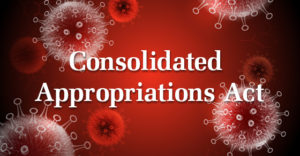
How can your business benefit from the Consolidated Appropriations Act?
 The Consolidated Appropriations Act of 2021 (CAA) was signed into law in late December. The sprawling legislation contains billions of dollars in additional stimulus funding in response to the COVID-19 pandemic, as well as numerous unrelated provisions. Let’s take a closer look at the provisions that are most likely to affect your company’s bottom line.
The Consolidated Appropriations Act of 2021 (CAA) was signed into law in late December. The sprawling legislation contains billions of dollars in additional stimulus funding in response to the COVID-19 pandemic, as well as numerous unrelated provisions. Let’s take a closer look at the provisions that are most likely to affect your company’s bottom line.
Paycheck Protection Program
The CAA includes another $284 billion in funding for forgivable loans through the Paycheck Protection Program (PPP), for both first-time and so called “second draw” borrowers. New loans can be made through March 31, 2021, or until the funding is exhausted. The new law expands the allowable uses for PPP funds, provides a simplified forgiveness process for smaller loans, and clarifies the proper tax treatment of loan proceeds and forgiven amounts.
The second draw loans are intended for smaller and harder hit businesses. Eligible borrowers include businesses, certain nonprofits, self-employed individuals, sole proprietors and independent contractors.
To qualify for a second draw, a borrower must have no more than 300 employees and have used (or will use) all of the proceeds of its first PPP loan. Borrowers generally also must demonstrate at least a 25% reduction in gross receipts in one quarter of 2020 compared with the same quarter in 2019. For loans of $150,000 or less, a borrower can submit a certification attesting that it meets the revenue loss requirements on or before the date it submits its loan forgiveness application.
Loans are limited to 2.5 times average monthly payroll costs in the year prior to the loan or the calendar year, up to $2 million. Accommodation and food service businesses may receive loans for up to 3.5 times their average monthly payroll. Businesses can obtain only a single second draw loan, and businesses with multiple locations that are eligible under the initial PPP requirements can have no more than 300 employees per physical location.
The CARES Act, which created the PPP, limited the funds to payroll, mortgage, rent and utility payments. The CAA allows businesses to also apply the funds to:
- Covered operating expenses, including software or cloud computing services that facilitate business operations, product and service delivery, payroll processing, human resources, sales and billing, accounting or tracking supplies, inventory, records, and expenses,
- Uninsured costs related to property damage, vandalism or looting during 2020 public disturbances,
- Supplier costs according to a contract, purchase order or order for goods, in effect before taking out the loan, that are essential to the borrower’s operations, and
- Worker protection expenses incurred to comply with federal or state health and safety guidelines related to COVID-19 (for example, personal protective equipment, ventilation systems and drive-through windows).
As with the first round of PPP loans, full forgiveness requires a 60/40 cost allocation between payroll and nonpayroll costs. In other words, you must spend at least 60% of the funds on payroll over your covered period, which may range from eight to 24 weeks.
The CAA creates a simplified forgiveness application for loans up to $150,000. Such loans will be forgiven if the borrower signs and submits to the lender a one-page certification form from the Small Business Administration (SBA). The certification requires a description of the number of employees retained due to the loan, the estimated total amount of funds spent on payroll and the total loan amount. Borrowers must retain relevant records regarding employment for four years and other records for three years.
The CAA also eliminates the previous requirement that borrowers deduct the amount of any SBA Economic Injury Disaster Loan (EIDL) advances from their PPP forgiveness amount.
Additionally, the CAA addresses some of the confusion that had arisen regarding PPP tax issues. It specifies that a borrower need not include any forgiven amounts in its gross income. And — contrary to the position taken earlier by the IRS — it states that borrowers can deduct otherwise deductible expenses paid with forgiven PPP proceeds. The CAA also provides that tax basis and other attributes aren’t reduced by loan forgiveness (special rules apply to partnerships and S corporations). These tax provisions apply to second draw loans, too.
Other financial assistance
The CAA provides $20 billion for new EIDL grants for businesses in low-income communities and $15 billion for live venues, independent movie theaters and cultural institutions.
On the tax front, it states that a borrower’s gross income doesn’t include forgiveness of certain loans, emergency EIDL grants and certain loan repayment assistance provided by the CARES Act. As with PPP loans, you can deduct your otherwise deductible expenses paid with such forgiven amounts, and forgiveness won’t reduce your tax basis and other attributes (special rules apply to partnerships and S corporations). Similar treatment applies to targeted EIDL advances and Grants for Shuttered Venues.
Employee Retention Credit
To encourage businesses to maintain their workforces, the CARES Act created the Employee Retention Credit, a refundable credit against payroll tax for employers whose:
- Operations were fully or partially suspended due to a COVID-19-related governmental shutdown order, or
- Gross receipts dropped more than 50% compared to the same quarter in the previous year (until gross receipts exceed 80% of gross receipts in the earlier quarter).
Employers with more than 100 employees could receive the credit if they closed due to COVID-19. Those with 100 or fewer employees received the credit regardless of whether they were open for business.
The credit equaled 50% of up to $10,000 in compensation — including health care benefits — paid to an eligible employee from March 13, 2020, through December 31, 2020. The CAA extends the credit for eligible employers that continue to pay wages during COVID-19 closures or reduced revenue through June 30, 2021.
Notably, as of January 1, 2021, the CAA hikes the credit from 50% of qualified wages to 70%. It also expands eligibility by reducing the requisite year-over-year gross receipt reduction from 50% to only 20% and raises the limit on per-employee creditable wages from $10,000 for the year to $10,000 per quarter.
In addition, the threshold for a business to be deemed a “large employer” — and thus subject to a tighter standard when determining the qualified wage base — is lifted from 100 to 500 employees.
The CAA includes some retroactive clarifications and technical improvements regarding the original credit, as well. For example, it provides that employers that receive PPP loans still qualify for the credit for wages not paid with forgiven PPP funds.
Deferred payroll taxes
Businesses were given the option to withhold their employees’ share of Social Security taxes from September 1, 2020, through December 31, 2020. Those that did were originally directed to increase the withholding and pay the deferred amounts on a prorated basis from wages and compensation paid between January 1, 2021, and April 30, 2021.
Under the CAA, such employers now have all of 2021 to withhold and pay the deferred taxes.
Non-COVID-19 disaster relief
The CAA also acknowledges the recent disasters not related to the pandemic (for example, wildfires). Among other things, it provides a tax credit of up to $2,400 (40% of up to $6,000 of wages) per employee, to employers in qualified disaster zones.
The credit applies to wages paid, regardless of whether services were actually performed in exchange for those wages. The CAA also modifies the CARES Act to allow corporations to make qualified disaster relief contributions of up to 100% of their 2020 taxable income.
Business meals deduction
For 2021 and 2022, you can deduct 100% (up from 50%) for food and beverages as long as they’re “provided by a restaurant.” The IRS will likely issue guidance on the deduction, particularly the meaning of the term “provided by a restaurant.”
Retirement plans
The tax code allows “qualified future transfers” of up to 10 years of retiree health and life costs from a company’s pension plan to a retiree’s health benefits or life insurance account within the plan. These transfers must meet certain requirements (for example, the plan must be 120% funded) that pandemic-related market volatility has made too difficult to meet in some cases.
In response, the CAA allows employers to make a one-time election on or before December 31, 2021, to end any existing transfer period for any taxable year beginning after the election in certain circumstances.
The law also includes a partial termination safe harbor for retirement plans in light of 2020’s pandemic-related workforce fluctuations. Plans won’t be treated as having a partial termination (which would trigger 100% vesting for affected participants) if the number of active participants on March 31, 2021, is at least 80% of the number covered by the plan on March 13, 2020. The safe harbor applies to plan years that include the period beginning on March 13, 2020, and ending on March 31, 2021.
Charitable deductions
The CAA extends, through 2021, the CARES Act provision that increases the limitation on corporations’ cash charitable contributions from 10% of taxable income to 25%. Any excess corporate cash contributions will be carried forward to subsequent tax years. The limitation on deductions for donations of food inventory, which the CARES Act increased to 25% for 2020, is similarly extended through 2021.
Tax extenders
The CAA incorporates several “extenders” of tax breaks. For example, it extends both the New Markets Tax Credit and the Work Opportunity Tax Credit through 2025. The employer credit for paid family and medical leave is extended through 2025 for wages paid in tax years after 2020.
The law extends through 2025 the period for which an empowerment zone designation is in effect. But the enhanced expensing rules and nonrecognition of gain on rollover of empowerment zone investments are terminated for property placed in service in tax years beginning after December 31, 2020. Empowerment zone tax-exempt bonds and employment credits also weren’t extended beyond December 31, 2020.
A loaded law
At almost 5,600 pages, the CAA contains many more components that could impact your business and personal taxes. Please contact us if you have any questions about these or other provisions.
© 2021



